#How to repel moles
Explore tagged Tumblr posts
Text
Astarion: The Longer You Look
At first glance, Astarion looks immaculate. That’s part of the trick.
Too beautiful, really the kind of beauty people make excuses for, just to be close to it. He’s charming in a way that lands softly at first, like velvet over glass. His beauty is deliberate the soft curve of his mouth, the glimmer in his eyes, the laugh that never quite reaches them. His voice, smooth and cutting. His laugh, elegant and a touch too precise like it was rehearsed. Like he knows what you want to hear and gives it to you before you even speak.
But if you watch long enough, things start to slip.
His hair is too white. Not silvery or aged, but clean, like bone stripped bare in the desert. It never moves in the wind quite right too soft, too neat, like it's mimicking how hair should behave. It never gets tangled. It never lies flat for long. It moves like it has thoughts of its own when wind touches it. When he runs a hand through it, it falls back into place like water returning to stillness. Tav once brushed a strand from his brow and thought for a breath it didn’t feel like hair at all.
His stillness is the first thing that feels wrong. Not the poised stillness of a nobleman or trained killer but something older, something that doesn’t need to move unless it chooses to. When others are tired or hungry or overwhelmed, he stands perfectly composed and that stillness is unnerving. He doesn’t fidget. Never scratches an itch. Doesn’t tap his fingers or shift his weight. Never adjusts the fall of his cloak unless someone’s looking. He stands too still, like something holding its breath. And there’s the way he moves fluid, yes, graceful, yes but sometimes too quiet. You don’t hear him unless he wants to be heard. You think he left the room, and then he’s suddenly behind you, eyes curious, mouth smiling just a second too late. His footsteps make no sound unless he's pretending they do.
He is beautiful in the way a statue might be marble-pale and impossibly still. His skin is porcelain, yes, but not in the romantic way. Porcelain like a mask. Smooth, but too smooth. Pores are nearly invisible. No freckle, no mole, no scar. Light sits strangely on it, almost like it’s being repelled. His skin doesn’t glow so much as it reflects the world like porcelain under candlelight, never quite warming. He’s always the same eternal. Preserved. His eyes red, yes they do not glow, not really. But they catch. Sometimes they glint in the dark with a glimmer that isn't natural light a sharp flicker, like a cat’s. He doesn’t just look at people he studies them, like a predator choosing the softest place to bite. But where a beast’s eyes are wild, his are watching. Calculating. He never blinks too much. Never too little. Just enough. Too precise. Like he’s mimicking humanity. Like he’s remembering how people behave, and doing it by muscle memory, not instinct. When he laughs, it’s too smooth. No vocal scratch, no hiccup, no breath. Just sound. And when he stops laughing, it’s instant. Like someone cut a string.
When he’s hungry, everything sharpens.
His smile slows. His head tilts. His eyes track movement with eerie precision. His pupils narrow like a cat's. The red in his eyes sharpens to crimson. His mouth parts not wide, but just enough for you to see the tips of his fangs, longer than you remembered, sharper. His nails manicured and clean lengthen at the edges. And his hands those lovely, elegant hands they twitch at his sides. They look like they’d tear through silk or skin without effort.
It’s in the little things the way his shadow moves slightly out of sync with his body when the torchlight flickers, the way animals stare too long or go silent when he passes.
And yet, people are drawn to him. Like moths to flame. He doesn’t just act charming he feeds off the effect it has. The admiration. The attention. The closeness. He likes to be seen. He likes being beautiful.
But the truth is: beauty is bait.
And the predator underneath is always watching.
But Tav… Tav sees it all.
And doesn’t flinch.
And that, more than anything, makes him pause. Because predators know when something isn’t afraid.
And he's never had that before. _________________________________________________________ I love thinking that Astarion is, in his own way, a bit uncanny—not in an overtly monstrous way, but there's something subtly off about him. It's the kind of thing you only notice after observing him for an extended period—something vampires rarely experience, since they're not often watched so closely for so long. Thanks for reading! I hope you enjoyed <3 If you want to read some more, here's my MASTERLIST
#bg3#astarion#astarion ancunin#baldur's gate 3#bg3 astarion#astarion x tav#baldurs gate 3#astarion bg3#astarion x reader#astarion romance#uncanny astarion#baldurs gate 3 astarion#bg3 fanart#astarion fanfiction#astarion fanfic#astarion fandom#astarion headcanon#astarion headcanons
311 notes
·
View notes
Text
i'm here once again to convince you to consume new media :D
❗WUTHERING WAVES SPOILERS❗





-> right off the bat, stunning visuals. i lowkey love the way the token 'symbol' of the game resembles stars AND soundwaves in a way that remains prevalent
unfortunately, while it IS beautiful, it does make the gameplay a little janky. not to the point where it's hard to run, but it does feel a little like playing on slow wi-fi.

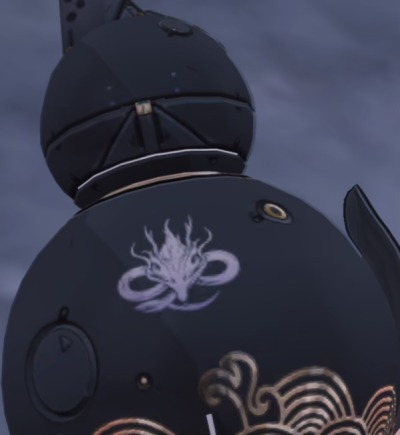
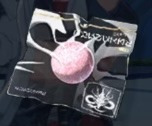
-> the worldbuilding is really cool, important figures in their cities aren't just like- a one and done sort of thing even if they aren't explicitly touched on anymore
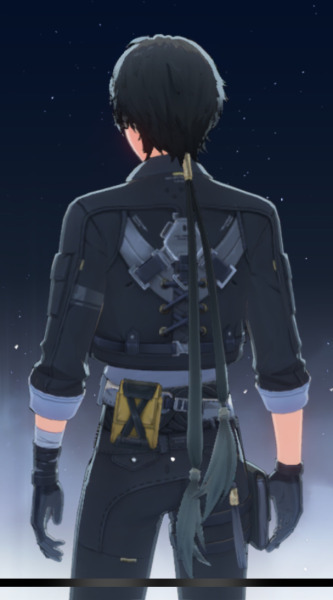

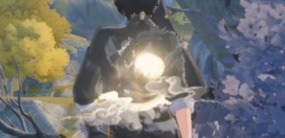
-> MC CHARACTER DESIGNS?? amazing. i really only chose the male Rover because I couldn't tell if those were ribbons or his actual hair {i still have no idea} -> plus- the sheathing animation?? the cloud and moon? beautiful




my favorite part of any media will always be how different the characters are -> I love Chixia's baby face and her freckles, Sanhua's mismatching pupils and her mole -> YANGYANG'S FEATHER SHAPED HAIR THAT GLOWS

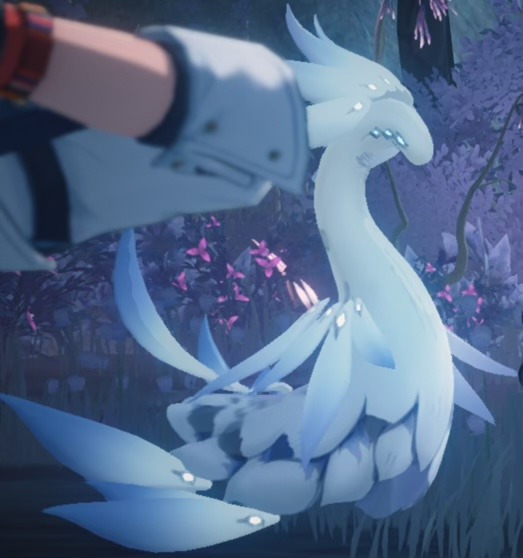
-> the mechanics are also incredible, modern in a sense but also like- extremely fantastical? they're a lot more complex then other open world exploration games guns replace archers, but you can also throw around a giant bird.. thing
it kind reminds of a mix of TOTK mechanics and genshin, but in it's own unique amalgamation of the two. also you can turn into creatures and repel through the air like Spider-Man


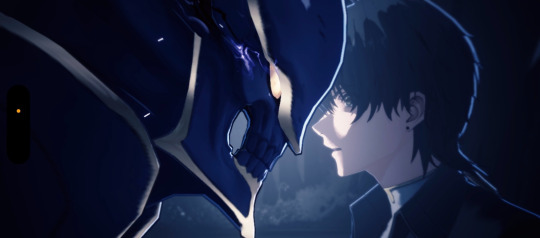
-> in all honesty, i think it's trying to take itself maybe just a bit too seriously? the storyline is rich and captivating so far but it lacks a sort of silliness and whimsy
which i understand, Wuthering Waves is trying to be it's own thing in a game where companies like Hoyoverse and Nintendo have dominated the field not to mention, the diehard fans of Hoyoverse games are rabid. if anything bares even a smidge of resemblance to genshin or hsr, it gets torn to pieces almost immediately -> it's not all fans, nor am i implying as such, but it IS a loud majority.
as always lmk if there are any other things you want me to give my thoughts on, i always love getting requests and interacting with you all >W<
#i lowkey don't trust yangyang#wuthering waves#wuwa#wuwa official#yangyang#chixia#baizhi#new media#media analysis#wuwa rover#sanhua#the ramblings of a fallen star#honkai star rail#genshin impact
86 notes
·
View notes
Text
Desperate Living
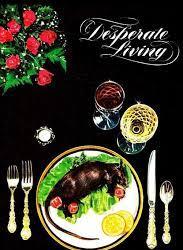
For his first film with an original score, John Waters told composer Chris Lobingier he wanted something like DOCTOR ZHIVAGO (1965). That’s only fitting, since DESPERATE LIVING (1977, Criterion Channel) is arguably the most epic film in his “Trash Trilogy.” It has everything: an evil queen, a revolution, an entire city constructed in the backwoods of Maryland, lesbian lovers and death at the hands of a large woman’s butt. It’s so tasteless the critic from “Good Housekeeping” walked out after ten minutes. But it’s also screamingly funny. In fact, with its combination of twisted logic, rapid-fire dialog and offbeat romantic relationships, I’m tempted to label Waters the pustulant Preston Sturges.
The film’s titles play over an elegant table setting with romantic music that might fit easily into a Douglas Sirk melodrama. Then someone deposits the main course on the table, a roasted rat on a bed of lettuce and cherry tomatoes. The image is both repellant and strangely beautiful, and it’s the perfect metaphor for what’s to follow. Recently released from a mental institution, Peggy Gravel (Mink Stole) has a breakdown that leads to her husband’s death. She runs off with her maid (Jean Hill) and ends up on Mortville, a shanty town ruled over by the evil Queen Carolotta (Edith Massey). And then things get really strange.
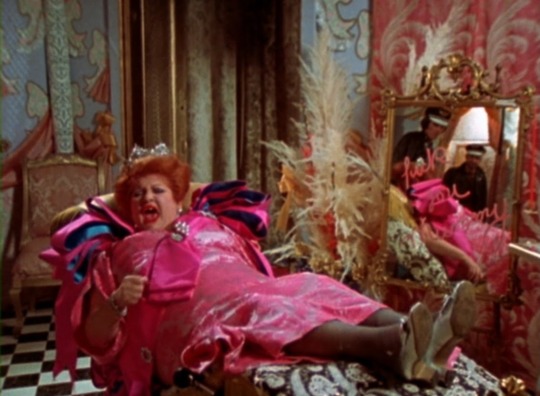
Waters’ films are exercises in bad taste, but with his controlling intelligence behind them, they’re bad taste turned into art. There’s a rhythm to the shocks and funny lines that propels the film, and if you don’t let it offend you, you’ll have a rollicking good time. His bad taste is also political, like the best of camp. He deliberately perverts our notions of what a movie should be and thereby dismantles traditional binaries of good and bad, gay and straight, ugly and beautiful. In this film it’s done to attack the notion of authority. While they’re on the run, Stole and Hill are accosted by a cop who uses his power to demand their underwear in return for letting them go free and pointing them towards Mortville. The ultimate example of corrupt power, of course, is Massey, who orders those who defy her killed, feasts on sweets and pizza while her subjects are starving and issues inane proclamations so she can laugh at her subjects for following them. Viewed today, the film seems particularly timely. Isn’t Queen Carlotta just President Trump with bigger breasts?
This was the only Waters’ film not to feature Divine during the actor’s lifetime (he was committed to a production of WOMEN BEHIND BARS). But that gives the rest of the Dreamlanders a chance to shine. In her only major role, Susan Lowe steps into the part planned for Divine, and hilariously shouts and growls her way through her role as the aggressive lesbian Mole. Massey’s Carlotta seems the lovechild of W.C. Fields and Mae West and is particularly hilarious issuing orders non-stop as her police carry her around on a chaise longue. Waters discovery Hill is also very funny and at times almost seems human as the murderous maid. But the best role goes to Mink Stole. During the breakdown that starts the film, she screams at children playing outside her window (“this isn’t some Communist day care center”), a wrong number (“How can you repay the last 30 seconds you’ve stolen from my life? I hate you, your husband, your children and your relatives!”) and the husband trying to sedate her. It’s a comic tour de force as good as anything you’d find in the best screwball comedies.

3 notes
·
View notes
Photo

Tawny and Southern mole crickets are considered garden pests and are often found in warmer, southern regions. If you don't want to welcome predators that can harm your yard, you can introduce certain wasps or nematodes for biocontrol.If you see more than two to four mole crickets per 2-square-foot radius, it may be time to call a professional. A patchy lawn in late summer could be due to any number of problems, but if you live in a southern state, mole crickets may be the culprits. These imported insect pests tunnel into turfgrass with paddle-like forelegs, feeding on roots and leaving brown and bare areas marked by small mounds of soil. Mole crickets are a significant problem from the Carolinas to Florida. Find out how to manage populations and keep your lawn and gardens cricket-free. What Are Mole Crickets? Mole crickets live in and tunnel through soil with several introduced species that cause significant damage to lawns and gardens in the southern U.S. Tawny and Southern mole crickets, Neoscapteriscus vicinus and Neoscapteriscus borellii, are species from South America that populate warmer climates in the south. Northern mole crickets, Neocurtilla hexadactyla, are native to the eastern half of the U.S., west to Texas, and are not considered pests. Want more gardening tips? Sign up for our free gardening newsletter for our best growing tips, troubleshooting hacks, and more! How to Get Rid of Mole Crickets These small brownish crickets tend to target specific areas in your lawn. Soak suspect bare patches with soapy water or a water and vinegar mix. Do this during the warm season when adult crickets move toward the soil surface to mate. They'll quickly come up for air. Several methods have possibilities for control and depend on the severity of the problem. Organic Controls Mole crickets are a food source for raccoons, possums, armadillos, frogs and snakes, insect-eating birds, spiders, and other soil-dwelling insects like ground beetles and assassin bugs. Encourage these predators by providing habitat, including shelter and a water source. Keep in mind that digging rodents may cause more damage than the crickets, and some, like skunks, may not be welcome in your yard. Natural scent repellents may drive mole crickets to depart for a friendlier location. Eucalyptus, lemongrass, citronella, peppermint, and vinegar act as effective deterrents. Try planting strongly scented herbs around your lawn and gardens, or spray a dilution of essential oils and water on affected areas. Biocontrols Natural predators keep populations of native Northern mole crickets in check. Southern and tawny mole crickets have no natural predators, but there are still two options that can work for you. Larra wasps, Larra bicolor, deposit an egg on each cricket, where newly hatched larvae feed on the host, killing it. These parasitic wasps don't harm humans and spawn three generations every year, eradicating up to 25 percent of local mole cricket populations with each generation. Host plants include shrubby false buttonweed, Spermacoce verticillata, partridge pea, Chamaecrista fasciculata, and white pentas, Pentas lanceolata. Steinernema scapterisci, a parasitic nematode imported from South America, is another effective biocontrol. Released into the soil, these microscopic roundworms hunt and infiltrate the bodies of mole crickets to lay eggs. Larvae feed on the host until mature, then move into the soil to look for new hosts on which to lay their eggs. They can be purchased online and at specialty garden centers. What is biocontrol? Biocontrol is a method of managing insect pests by introducing a beneficial organism that parasitizes or destroys the pest. Pesticides Pesticides give faster results than most organic methods but are best used sparingly, only in spots where mole crickets are active. Effective pesticides include neonicotinoids, organophosphates, and synthetic pyrethroids. They come in granules, liquids, or bait balls and can be purchased at most home and garden centers. Apply in early summer when larvae are newly hatched and feeding close to the surface. While damage is most visible in late summer, waiting to treat your lawn won't be as effective. Immature crickets are migrating deeper into the soil, and adults, closer to the surface, have better resistance. Water your lawn the day before and again following application unless you use bait balls. Withhold water for three to four days after setting out cricket baits. Spot treat affected areas to limit use and apply pesticides late in the day. If repeat treatment is necessary, consider using a different formula. Mole crickets can build tolerance with repeated applications of the same product. Pesticide Safety Follow label directions when using pesticides. Wear protective clothing, eyewear and gloves when recommended. Good Lawn Maintenance Prevention is worth a pound of cure, so stick to a regular lawn maintenance schedule. Fertilize at the correct time, keep turfgrass adequately watered, and mow at the best height for your grass type and climate. When to Call a Professional If you suspect an infestation with multiple areas throughout your lawn developing signs of cricket damage, it may be practical and more cost-effective to call a professional. They are licensed to use strong formulas not available to homeowners. Depending on how the turf area is used is also a factor in how aggressively you need to treat the problem. Damage caused by mounding can be hazardous on playing fields and lawns with intense activity or small children. How many mole crickets are too many? Soak suspected areas in late summer with two tablespoons of liquid soap dissolved in a gallon of water. Or use a combination of vinegar and water. If two to four crickets surface in a 2-foot square area, take steps to reduce the population. FAQ Adult mole crickets are most active in late summer when adults come to the surface to mate. This is when you'll likely find mounded soil where mated females have started tunneling underground to deposit their eggs. Female mole crickets tunnel 4 to 12 inches deep to lay eggs. During winter months, males and females can burrow several feet deep into the soil. Source link
2 notes
·
View notes
Photo

Tawny and Southern mole crickets are considered garden pests and are often found in warmer, southern regions. If you don't want to welcome predators that can harm your yard, you can introduce certain wasps or nematodes for biocontrol.If you see more than two to four mole crickets per 2-square-foot radius, it may be time to call a professional. A patchy lawn in late summer could be due to any number of problems, but if you live in a southern state, mole crickets may be the culprits. These imported insect pests tunnel into turfgrass with paddle-like forelegs, feeding on roots and leaving brown and bare areas marked by small mounds of soil. Mole crickets are a significant problem from the Carolinas to Florida. Find out how to manage populations and keep your lawn and gardens cricket-free. What Are Mole Crickets? Mole crickets live in and tunnel through soil with several introduced species that cause significant damage to lawns and gardens in the southern U.S. Tawny and Southern mole crickets, Neoscapteriscus vicinus and Neoscapteriscus borellii, are species from South America that populate warmer climates in the south. Northern mole crickets, Neocurtilla hexadactyla, are native to the eastern half of the U.S., west to Texas, and are not considered pests. Want more gardening tips? Sign up for our free gardening newsletter for our best growing tips, troubleshooting hacks, and more! How to Get Rid of Mole Crickets These small brownish crickets tend to target specific areas in your lawn. Soak suspect bare patches with soapy water or a water and vinegar mix. Do this during the warm season when adult crickets move toward the soil surface to mate. They'll quickly come up for air. Several methods have possibilities for control and depend on the severity of the problem. Organic Controls Mole crickets are a food source for raccoons, possums, armadillos, frogs and snakes, insect-eating birds, spiders, and other soil-dwelling insects like ground beetles and assassin bugs. Encourage these predators by providing habitat, including shelter and a water source. Keep in mind that digging rodents may cause more damage than the crickets, and some, like skunks, may not be welcome in your yard. Natural scent repellents may drive mole crickets to depart for a friendlier location. Eucalyptus, lemongrass, citronella, peppermint, and vinegar act as effective deterrents. Try planting strongly scented herbs around your lawn and gardens, or spray a dilution of essential oils and water on affected areas. Biocontrols Natural predators keep populations of native Northern mole crickets in check. Southern and tawny mole crickets have no natural predators, but there are still two options that can work for you. Larra wasps, Larra bicolor, deposit an egg on each cricket, where newly hatched larvae feed on the host, killing it. These parasitic wasps don't harm humans and spawn three generations every year, eradicating up to 25 percent of local mole cricket populations with each generation. Host plants include shrubby false buttonweed, Spermacoce verticillata, partridge pea, Chamaecrista fasciculata, and white pentas, Pentas lanceolata. Steinernema scapterisci, a parasitic nematode imported from South America, is another effective biocontrol. Released into the soil, these microscopic roundworms hunt and infiltrate the bodies of mole crickets to lay eggs. Larvae feed on the host until mature, then move into the soil to look for new hosts on which to lay their eggs. They can be purchased online and at specialty garden centers. What is biocontrol? Biocontrol is a method of managing insect pests by introducing a beneficial organism that parasitizes or destroys the pest. Pesticides Pesticides give faster results than most organic methods but are best used sparingly, only in spots where mole crickets are active. Effective pesticides include neonicotinoids, organophosphates, and synthetic pyrethroids. They come in granules, liquids, or bait balls and can be purchased at most home and garden centers. Apply in early summer when larvae are newly hatched and feeding close to the surface. While damage is most visible in late summer, waiting to treat your lawn won't be as effective. Immature crickets are migrating deeper into the soil, and adults, closer to the surface, have better resistance. Water your lawn the day before and again following application unless you use bait balls. Withhold water for three to four days after setting out cricket baits. Spot treat affected areas to limit use and apply pesticides late in the day. If repeat treatment is necessary, consider using a different formula. Mole crickets can build tolerance with repeated applications of the same product. Pesticide Safety Follow label directions when using pesticides. Wear protective clothing, eyewear and gloves when recommended. Good Lawn Maintenance Prevention is worth a pound of cure, so stick to a regular lawn maintenance schedule. Fertilize at the correct time, keep turfgrass adequately watered, and mow at the best height for your grass type and climate. When to Call a Professional If you suspect an infestation with multiple areas throughout your lawn developing signs of cricket damage, it may be practical and more cost-effective to call a professional. They are licensed to use strong formulas not available to homeowners. Depending on how the turf area is used is also a factor in how aggressively you need to treat the problem. Damage caused by mounding can be hazardous on playing fields and lawns with intense activity or small children. How many mole crickets are too many? Soak suspected areas in late summer with two tablespoons of liquid soap dissolved in a gallon of water. Or use a combination of vinegar and water. If two to four crickets surface in a 2-foot square area, take steps to reduce the population. FAQ Adult mole crickets are most active in late summer when adults come to the surface to mate. This is when you'll likely find mounded soil where mated females have started tunneling underground to deposit their eggs. Female mole crickets tunnel 4 to 12 inches deep to lay eggs. During winter months, males and females can burrow several feet deep into the soil. Source link
2 notes
·
View notes
Text
The Court of Queen Valaena is proud to announce the arrival of VAEGON, PRINCE of HOUSE TARGARYEN (SH) to King’s Landing. The TWENTY-SIX year-old CISMAN is known to be ATHLETIC & SOCIABLE but will this Winter reveal that they are also MATERIALISTIC & VAINE? They look like NICHOLAS GALITZINE, and they DO NOT BELIEVE the tales of the Other returning. Here is hoping they can band together with everyone else, and repel the coming darkness! [ Devin, EST, He/Him/His, 26. ]


𝐁𝐀𝐒𝐈𝐂𝐒
𝐅𝐔𝐋𝐋 𝐍𝐀𝐌𝐄. vaegon targaryen. 𝐍𝐈𝐂𝐊𝐍𝐀𝐌𝐄. vae. 𝐓𝐈𝐓𝐋𝐄𝐒. ser, prince. 𝐀𝐆𝐄. twenty-six. 𝐆𝐄𝐍𝐃𝐄𝐑. cis man ( he/him/his ). 𝐌𝐀𝐑𝐈𝐓𝐀𝐋 𝐒𝐓𝐀𝐓𝐔𝐒. single. SEXUALITY. homosexual. 𝐑𝐄𝐋𝐈𝐆𝐈𝐎𝐍. faith of the seven. 𝐀𝐅𝐅𝐈𝐋𝐈𝐀𝐓𝐈𝐎𝐍. himself, house targaryen. 𝐒𝐏𝐎𝐊𝐄𝐍 𝐋𝐀𝐍𝐆𝐔𝐀𝐆𝐄𝐒. common tongue, valyrian.
𝐀𝐏𝐏𝐄𝐀𝐑𝐀𝐍𝐂𝐄
𝐇𝐄𝐈𝐆𝐇𝐓. 6'0". 𝐖𝐄𝐈𝐆𝐇𝐓. 190 lbs. 𝐁𝐔𝐈𝐋𝐃. athletic. 𝐄𝐘𝐄𝐒. lavender. 𝐇𝐀𝐈𝐑. dark brown. 𝐂𝐎𝐌𝐏𝐋𝐄𝐗𝐈𝐎𝐍. fair. 𝐃𝐈𝐒𝐓𝐈𝐍𝐆𝐔𝐈𝐒𝐇𝐈𝐍𝐆 𝐌𝐀𝐑𝐊𝐒. scar on his shoulder, mole above his lip.
𝐏𝐄𝐑𝐒𝐎𝐍𝐀𝐋𝐈𝐓𝐘
𝐌𝐎𝐑𝐀𝐋 𝐀𝐋𝐈𝐆𝐍𝐌𝐄𝐍𝐓. chaotic neutral. 𝐀𝐓 𝐓𝐇𝐄𝐈𝐑 𝐁𝐄𝐒𝐓. charismatic, leisurely, passionate, well bred. 𝐀𝐓 𝐓𝐇𝐄𝐈𝐑 𝐖𝐎𝐑𝐒𝐓. aloof, arrogant, hedonistic, indulgent, materialistic, & vain.
𝐂𝐎𝐍𝐍𝐄𝐂𝐓𝐈𝐎𝐍𝐒
𝐏𝐀𝐑𝐄𝐍𝐓𝐒. prince tbd targaryen & princess tbd targaryen of summerhall. 𝐒𝐈𝐁𝐋𝐈𝐍𝐆𝐒. 2 younger siblings . 𝐈𝐒𝐒𝐔𝐄. none. 𝐎𝐓𝐇𝐄𝐑. aurum, vaegon's gold and pink dragon.
Vaegon was born during a warm summer, on a beautiful day.
Vaegon is a gifted tourney knight and sailor. However, he dislikes actual fights and battles. Blood makes him squeamish. Despite this, he was knighted at seventeen.
Vaegon cannot read, despite the maesters best efforts he never could grasp reading more than a few words.
Vaegon loves clothes and jewelry and the best of everything he can get his hands on. How he presents himself is very important to him. One of his ears are pierced, and he loves rings.
Despite his inability to read or write it, Vaegon can speak Valyrian.
Per Targaryen custom when he was born, Vaegon had a dragon egg placed in his crib. It was a golden egg that hatched into a beautiful golden scaled dragon, with pink membrane. Its fire is gold specked with pink.
3 notes
·
View notes
Text
Jack Cooke's Travel Log: Grayditch - 22/08/2277
(prev) (next) (master)

"Oh hey! It's finally working again! I knew a little percussive maintenance would fix 'ya It's been a few days since my last entry, so I've got a lot to fill you in on!"
"Firstly, I was able to get that landmine back to Moira! You should've seen the look on her face! I've never seen anyone so excited to handle a mine before. She practically snatched that thing out of my hands and started stripping it down, eventually she handed it back to me in the form of a lunch box... Apparently it's called a "Bottlecap Mine" 'supposed to pack more of a punch than 'ya average fragmentation mine, It's a nifty 'lil gadget I have to admit! She even gave me the plans to make my own!"
"After that, she wanted me to test out a new invention of hers. It's supposed to repel mole rats! I don't even want to know how she made that thing, it fucking glows green and smells like ozone or ammonia… I'm not even sure it was safe for humans, let alone mole rats! She pointed me towards some sewers in D.C to test this thing out… That was before I got side-tracked by some kid…"
"I was down by the Super-Duper-Mart when he came sprinting 'outta nowhere like a bat out of hell! Poor thing was shaking like a leaf, could hardly catch his breath, kept raving about 'monsters'. I was able to get him to sit down, have some water and calm down. Said his name was 'Brian Wilks' and that he came from a nearby settlement called Grayditch, that it was under attack from these 'monsters' and that he needs help saving his dad.. This kid and I.. we're in the same boat.. It was tugging at my heart-strings just to see that… I mean, what kinda heartless bastard would I be if I said no? So 'course I agreed to help! 'Don't worry, I'm strong! I'll save your dad!' I still can't believe I said that, but it seemed to calm him down enough at the time.."
"It didn't take us that long to get to Grayditch, you could see the smoke from miles away, and that smell.. God, that fucking smell.. I can't even begin to describe it.. I know what death smells like, what decay smells like. I'm kinda used to it now, I'm ashamed to admit.. But nothing prepares you for what burning corpses smell like.. And for a fucking kid to witness that? That poor fucking kid..."
"Giant fire-breathing ants, that was not what I expected when I went deeper into the settlement. At worse, I thought maybe those 'Super Mutant's since we're close to D.C.. That was just plain fucked up.. But it also made no sense? I'd encountered Giant Ant's before and none of them spat fire... I didn't like it.. Something about it wasn't natural.."
"I managed to find Brian's father in an old town house.. What was probably their home.. Ya'know, I've seen some messed up things in my few days being on the surface, but... that was probably the worst.. He was slumped up against some wall, just.. Blackened and charred, his eye's had melted so it was just hollow sockets staring back at me.. I couldn't stay in the house after that. I felt dizzy, my ears were ringing something awful.. Never felt so nauseous in my life.. I managed to get back into the house and cover the body with an old sheet, I don't want Brian to stumble across that, he's been through enough. It's got me thinking though.. Is this how I'm going to find my father? Dead in some ruin? Savaged by some wasteland creature? He's a vault-dweller like me! He has no idea how to survive out here! I mean, what're the odds that he made it to Megaton? Hell, that he even made it down the hill from the Vault? Ever since I saw that, I couldn't stop thinking about it.. Am I ever going to find him alive again? But uhh- I think what's worse is not knowing, so I'll keep going.. For now.. And just hope I don't end up like the Wilks..."
"Brian took the news well, as well as anyone can, let alone a kid. I wish I could just let him mourn.. But I also had to learn more about the ants, make sure this doesn't happen any place else. Of course, had no idea where they came from, but he pointed me toward a shack his father built instead. It was owned by a scientist that recently moved into the town, a 'Doctor Lesko' according to his terminal, he wanted to shrink the ants back down to their smaller size and had set up a lab inside the nearby metro station. So, I decided to check on the laboratory, maybe see if the doc was still alive and if he wasn't, maybe put down the ant colony's queen."
"Honestly? A part of me wishes that I didn't go down there. I managed to find Doctor Lesko.. He was in his lab, not expecting any visitors. I confronted him on what happened to Grayditch.. His response made my fucking blood boil.. He didn't care what happened to the town, 'necessary sacrifices' to further his own research! As far as he's concerned, he isn't responsible for what happened, nor does he feel any remorse. What a fucking bastard! An entire town wiped out because of his incompetence, a child is now fatherless because of it, not to mention the trauma he has to live with now! I was so close to putting a bullet in him, hell, I fucking should've. Instead, I decided to 'help' with his experiment by clearing the way to the ant queen so he could adjust the mutagen he has using. I won't lie, I was tempted to kill the ant queen, ruin his experiment and make this can't happen to another settlement. But I didn't, I bit my tongue and did what he asked... The prick wanted to 'reward' me for my work, I told him he can fucking sit and swivel on it and left."
"Which leads me to now, I can't have Brian staying on his own, it's too dangerous. I'm walking him back to Megaton, he can stay with Moira for a bit while I track down his aunt in a place called 'Rivet City', I'll ask around for its location when I'm back in town.."
#fallout#fallout 3#fallout oc#oc; jack#been a while since i've done one of these lol#just really had the urge to write this today for some reason#i try to base these off where i am in a playthrough and what I've seen and done in that playthrough but its been like 3/4 weeks since I did#this quest so I hope I've remembered well enough#GOD this went way longer than I expected it too lmfao#i only intended it to be a shortish one#instead its over 1000 words and covers the entire Those! quest#probably the longest entry so far lol
5 notes
·
View notes
Text
Another Sunday
Oh my goodness, how long has it been? My weeks are a blur. Not even fun blurs. But I refuse to use this space to complain. Let's talk about what's GOOD.
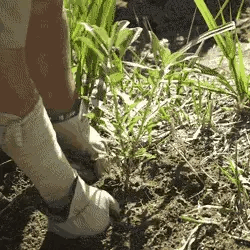
That's right, I've stolen some time to play in the dirt. Hallelujah! I worked a long week last week and then spent Saturday doing a community outreach gig for the library, but today I played. It's so good for my soul.
The zinnia seeds I scattered a week or so ago have germinated and I'm seeing tiny green promises.
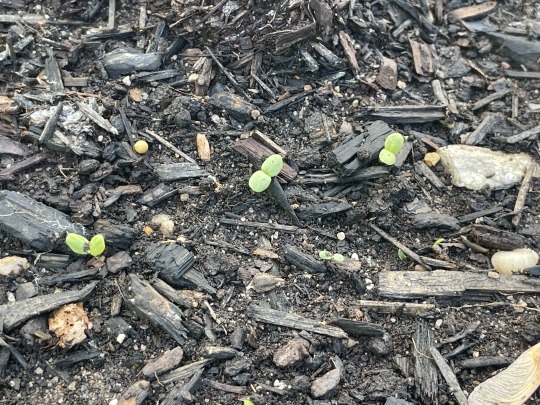
Behind the zinnias I popped some sunflowers seeds into the ground and one has already broken through.
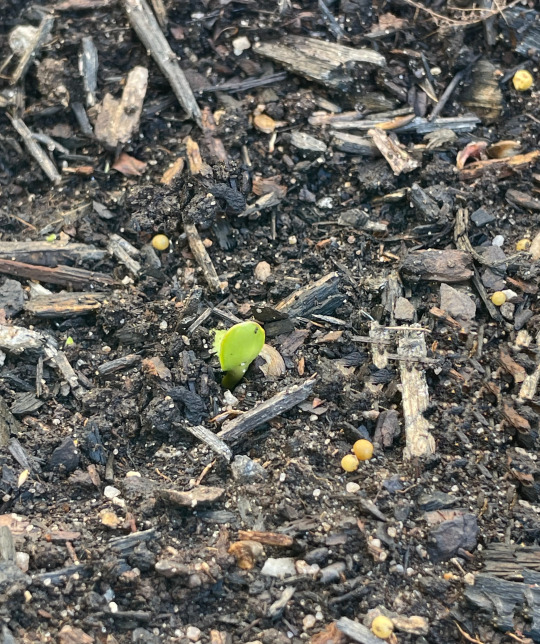
Yippee! I'm so excited. Of course, I've also spotted a curious bunny in the yard, and a family of groundhogs has moved in next door. They'd better stay away from my tender young plants. In other blooming news, the clematis I planted last spring came back and is already climbing the porch railing. Isn't she lovely?
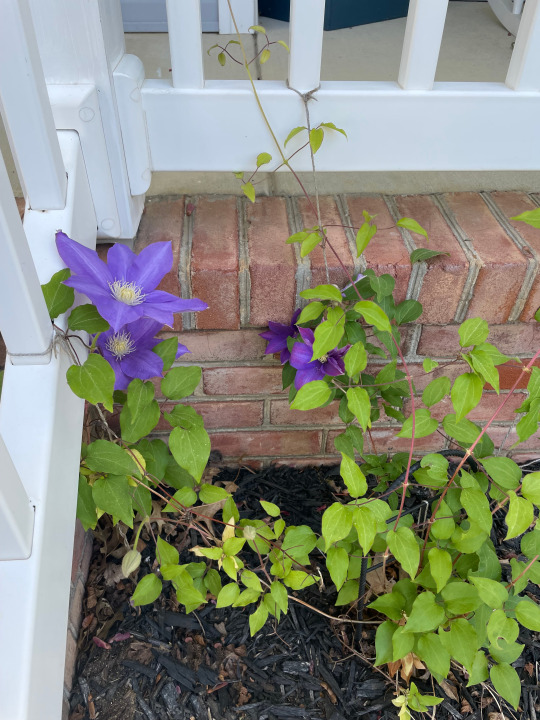
I hope she covers us in blooms. I've put a planter on one side of the front steps. IT's got a tumble of flowers that will eventually fill in, and smack dab in the middle is rosemary that will get tall and woody.

Rosemary should be planted by a garden gate, but I don't have a garden gate. The front door will have to do. I'll certainly enjoy using that rosemary in summer dishes.
I purchased a wonderful rolling raised bed and put basil and dill in it, surrounded by marigolds, of course - nature's pest repellant. I can keep my eye on it from the kitchen and run out and pluck what I need for dinner.

I know, I know, that patchy grass is a nightmare. We had a serious mole issue and we're on the mend. We'll have a beautiful lawn again in no time. I'm manifesting it. My spirits lift when things around me are growing. Even better, when working the dirt results in beautiful, bright colors - delightful! My little lilac bush has a bloom, my hydrangea is filling out, and the tiny Zepherine climbing rose has tripled in size and is reaching for the porch. Beauty, beauty, beauty everywhere. That's my goal. Brace yourself for an abundance of flower photos this summer. In other news, you know I've been scouring the info on this year's Kentucky Derby field. Imagine my excitement when I saw a horse named Seize the Gray. I'm not sure he'll make the cut, but if he does that may be where I put my money. I also like the looks of Resilience. If that hasn't been a theme in my life, I don't know what has. Then there's Forever Young, which reminds me of a favorite Rod Stewart song. Choices, choices. I only have a few days to decide where to lose my cash. I won't be doing a Derby Day spread because we'll be going over the bridge on Saturday to play with Little Miss while her parents enjoy some time together. Jamie's birthday is mid-week, but we'll celebrate on Saturday. They can go have some free time, then we'll do dinner, cake, and presents. Low key, but lots of love. A winning horse would be icing on the cake. I need to wrap this up, I'm in the middle of creating cardboard pine trees for a display at work. They'll be in the children's room along with a tent and a sign that says "Readers are happy campers." Getting these dang trees to stand upright has taken some time. Turns out I'm an artist, not an engineer. I think I've got it conquered, now just a few dabs of paint and they'll be good to go. Success! I know this has been a boring post, but I felt the need to post something. I miss this little blog. I've been talking to you through this space since July of 2007. There's been a lot of life lived between then and now. Thank you for sharing it with me. I feel like there's a lot of interesting life ahead, too. There's something big on the horizon, I don't know what yet, but my gut tells me that there is. I hope it's something wonderful. On that note, I'll sign off, wishing wonderful things for you as well. What is meant for us will find us, don't you think? We just need to keep our hearts open to possibilities. So put out a welcome mat for good things to come, be ready for happiness. Sending out lots of love, take what you need and pass it on. Stay safe, stay well. XOXO, Nancy
5 notes
·
View notes
Text
Nessa
Here you can find their faces
Age: 26/27 Species: Half Magma Golem Sexuality: Demisexual Pronouns: She/They
Personality: Nessa is resilient having learned to navigate difficulties and carve out a new life in Pelican Town for herself. Her experiences in life built a deep empathy within her, making her emotionally compassionate and kind-hearted. Once she finds something she truly cares about, she commits to it with unwavering determination and passion.
Her playful and teasing nature shines through in her interactions with friends. Despite her lighthearted side, she is self-disciplined, carefully managing her emotions and powers to prevent past mistakes from recurring. Generally, she maintains a serious and stoic demeanor, particularly around unfamiliar people.
Nessa is explorative, finding solace and comfort in the heat of the mines, especially the hotter levels. Due to her naturally high body temperature, she often feels cold and has to repeatedly reassure Harvey that she is not sick or overheating.
A bad habit from her high school days is smoking, yet her main weakness is that while water doesn’t harm her, the cold does, both significantly weaken her powers, making them ineffective depending on the temperature and how soaked she is.
Life: Early Childhood: Nessa was abandoned by her biological mother, Elora, on a random ass doorstep. She was adopted by a loving couple who raised her as their own child. (Her dad is Grandpa’s son)
Discovery of Powers: Her adoptive parents and Nessa, discovered her powers at a young age, when her dad gave her a bottle of firestarter to hand to her mom. She got too excited, and her body warmed up too much, causing the bottle to explode. This incident frightened her mom, who struggled to accept Nessa’s new abilities.
Emotional Turmoil: Nessa begged her adoptive mother to stay with them, promising she would be a good child and never let it happen again. Despite her pleas, her mother couldn't handle her fear of Nessa and left
Relocation: After her parents' divorce, Nessa lived with her dad and grandfather on the farm for a year and a half while her dad got back on his feet. During this time, she fell in love with the valley, meeting the ASS trio as infants.
New Life: Her dad raised her with a somewhat normal life, teaching her to keep her emotions in check to control her powers. They grew close, and she cherished the time spent with him.
Inheritance: Her dad gave her grandfather’s letter and land deed on his deathbed, passing on the family legacy to Nessa.
Job at Joja: Nessa worked at Joja for a few years, feeling lost and unsure of her purpose, and her place in the world.
New Beginnings: She eventually arrived in Pelican Town, where she was welcomed with open arms by Robin. This acceptance brought her to tears. Meeting Dante:
After living in Pelican Town for a year, she met her older brother, Dante, in the saloon. Despite his annoying habits, she loves him dearly.
Living with Dante: Nessa now lives with Dante, who has helped her come out of her shell more.
Unexpected Sibling 2: Recently, she opened the front door to find their younger sister, Carra, standing there
Physical Traits: Appearance: Body runs way hotter than normal, short (5'0"), strong but not muscular, dark brown hair, shaved on the sides and back, red eyes, freckles, mole under her right eye, large nose, leg hair
Abilities:
Practical: Basic Flame Manipulation: Creates small, controlled flames useful for lighting candles or starting small fires. Body Heat Generation: Learned to control internal temperature, warm water for cooking, heating small spaces, or providing warmth in cold environments.
Physical: Fire Creation: Basic flame production, as large as a basketball before it becomes harmful to others Flame Wall: Conjures a substantial wall of fire to block paths or protect areas, capable of burning or repelling most things that come into contact with it.
Weapon: Flaming Fists: Creates gauntlets made of flames that enhance the power of punches and cause burn damage on impact. Fire Kick: Extends flames to cover legs and feet, enhancing the power and effect of kicks. Inferno Grenades: Forms spherical orbs of fire that explode on impact, spreading fire and intense heat over a wide area.
2 notes
·
View notes
Text
Day Eight: The Word Works
Daily Scripture:
Isaiah chapter 55, verses 10-11
"The rain and snow come down from the heavens and stay on the ground to water the earth. They cause the grain to grow, producing seed for the farmer and bread for the hungry. It is the same with my word. I send it out, and it always produces fruit. It will accomplish all I want it to, and it will prosper everywhere I send it."
Read it for yourself if you'd like! (Translation may be slightly different):
https://www.bible.com/bible/59/isa.55.10
https://www.bible.com/bible/59/isa.55.11
.....
Quoting devotional:
Recently, i was playing with my son in the backyard when i noticed several small mounds of dirt that were connected by underground tunnels. As it turned out, we had a mole problem. If you aren't familiar with moles, they are ugly, (Charlie here, I DISAGREE THEY'RE ADORABLE-) little pests that dig their way through the dirt and destroy beautiful lawns.
After discovering the handiwork of the mole, I did my research and bought a set of solar-powered lawn pegs which release a noise underground to scare off moles. A few days after planting the pegs, I checked on the lawn. Unfortunately, the tunnels had multiplied. (BAHA)
This went on for several weeks until I realized that the mole pegs weren't going to work.
Unlike the mole repellent pegs in my yard, God's word always gets results. Even if we can't see how God's word is making a difference in a situation, we can trust the promise of God. God's promise tells us that his word will accomplish what he wants it to.
Which area of your life can you speak God's word into, believing that God will use his word to bring about change? God's word is unlike a man-made product because it works all the time. In fact, there are more than three thousand promises in God's word, and none of them has been false throughout history. How does God's perfect track record affect your confidence in the power and consistency of his word? Let's try something. Try listing three areas in your life in which you need God's intervention. Remember those things and pray to God for help and strength to overcome those road blocks <3
What can I pray for?
Pray over the three areas you listed and believe that God will begin to work in those specific situations, relationships or needs. If you aren't sure of the words to pray, just pray the words of Jesus.
"May your will be done in [areas you listed] on earth, as it is in heaven."
......
Have a wonderful day, loves!💛
3 notes
·
View notes
Text
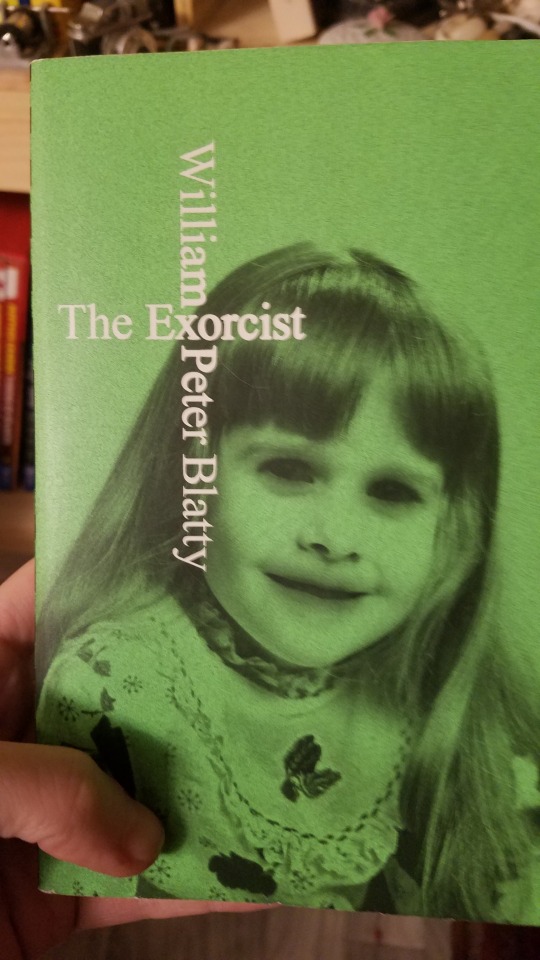
It too way too long to get this kid an exorcism, I mean yeah, I get it, rule out all reasonable explanations and mental illness but they decided to do it at page 297 out of a 363 page book
Though Merrin’s theory about possession is interesting, it’s not about the one being possessed, they were just a vulnerable vessel, the demon’s real purpose is through the victim to break the faith of those around them by showing them the worst of humanity
And the crucifix scene...ugh that was brutal, God I hope Regan doesn’t remember that
“Ah, well...at last I realized that God would never ask of me that which I know to be psychologically impossible; that the love which He asked was in my will and not meant to be felt as emotion. No. Not at all. He was asking that I act with love; that I do unto others; and that I should do it unto those who repelled me, I believe, was a greater act of love than any other.”
“How many husbands and wives,” Merrin uttered sadly, “must believe they have fallen out of love because their hearts no longer race at the sight of their beloveds. Ah, dear God! There it lies, I think, Damien...possession; not in wars, as some tend to believe; not so much; and very rarely in extraordinary interventions such as here...this girl...this poor child. No, I tend to see possession most often in little things, Damien: in the senseless, petty spites and misunderstandings; the cruel and cutting word that leaps unbidden to the tongue between friends. Between lovers. Between husbands and wives. Enough of these and we have no need of Saran to manage our wars; these we manage for ourselves...for ourselves.”
“And yet even from this-from evil-there will finally come good in some way; in some was that we may never understand or even see.” Merrin paused. “Perhaps evil is the crucible of goodness,” he brooded. “And perhaps even Satan-Satan, in spite himself-somehow serves to work out the will of God.”
“Glory be to God for dappled things,
For skies of couple-color as a brinded cow,
For rose-moles all in stipple upon trout that swim;
Fresh-fire-coal chestnut falls; finches' wings...
He fathers forth whose beauty is past change.
Praise Him.”
“But if all the evil in the world makes you think that there might be a devil, Chris, how do you account for all the good?”
“In forgetting, they were trying to remember.”
Side note, all the casual smoking, even by the priests, really sent home it was written in a different decade and all the casual, ice breaker, beating around the bush conversations or maybe that’s just me wanting people to get to the point
oh hey Screwtape Letters reference not often you see a book cameo in another book
0 notes
Photo

Tawny and Southern mole crickets are considered garden pests and are often found in warmer, southern regions. If you don't want to welcome predators that can harm your yard, you can introduce certain wasps or nematodes for biocontrol.If you see more than two to four mole crickets per 2-square-foot radius, it may be time to call a professional. A patchy lawn in late summer could be due to any number of problems, but if you live in a southern state, mole crickets may be the culprits. These imported insect pests tunnel into turfgrass with paddle-like forelegs, feeding on roots and leaving brown and bare areas marked by small mounds of soil. Mole crickets are a significant problem from the Carolinas to Florida. Find out how to manage populations and keep your lawn and gardens cricket-free. What Are Mole Crickets? Mole crickets live in and tunnel through soil with several introduced species that cause significant damage to lawns and gardens in the southern U.S. Tawny and Southern mole crickets, Neoscapteriscus vicinus and Neoscapteriscus borellii, are species from South America that populate warmer climates in the south. Northern mole crickets, Neocurtilla hexadactyla, are native to the eastern half of the U.S., west to Texas, and are not considered pests. Want more gardening tips? Sign up for our free gardening newsletter for our best growing tips, troubleshooting hacks, and more! How to Get Rid of Mole Crickets These small brownish crickets tend to target specific areas in your lawn. Soak suspect bare patches with soapy water or a water and vinegar mix. Do this during the warm season when adult crickets move toward the soil surface to mate. They'll quickly come up for air. Several methods have possibilities for control and depend on the severity of the problem. Organic Controls Mole crickets are a food source for raccoons, possums, armadillos, frogs and snakes, insect-eating birds, spiders, and other soil-dwelling insects like ground beetles and assassin bugs. Encourage these predators by providing habitat, including shelter and a water source. Keep in mind that digging rodents may cause more damage than the crickets, and some, like skunks, may not be welcome in your yard. Natural scent repellents may drive mole crickets to depart for a friendlier location. Eucalyptus, lemongrass, citronella, peppermint, and vinegar act as effective deterrents. Try planting strongly scented herbs around your lawn and gardens, or spray a dilution of essential oils and water on affected areas. Biocontrols Natural predators keep populations of native Northern mole crickets in check. Southern and tawny mole crickets have no natural predators, but there are still two options that can work for you. Larra wasps, Larra bicolor, deposit an egg on each cricket, where newly hatched larvae feed on the host, killing it. These parasitic wasps don't harm humans and spawn three generations every year, eradicating up to 25 percent of local mole cricket populations with each generation. Host plants include shrubby false buttonweed, Spermacoce verticillata, partridge pea, Chamaecrista fasciculata, and white pentas, Pentas lanceolata. Steinernema scapterisci, a parasitic nematode imported from South America, is another effective biocontrol. Released into the soil, these microscopic roundworms hunt and infiltrate the bodies of mole crickets to lay eggs. Larvae feed on the host until mature, then move into the soil to look for new hosts on which to lay their eggs. They can be purchased online and at specialty garden centers. What is biocontrol? Biocontrol is a method of managing insect pests by introducing a beneficial organism that parasitizes or destroys the pest. Pesticides Pesticides give faster results than most organic methods but are best used sparingly, only in spots where mole crickets are active. Effective pesticides include neonicotinoids, organophosphates, and synthetic pyrethroids. They come in granules, liquids, or bait balls and can be purchased at most home and garden centers. Apply in early summer when larvae are newly hatched and feeding close to the surface. While damage is most visible in late summer, waiting to treat your lawn won't be as effective. Immature crickets are migrating deeper into the soil, and adults, closer to the surface, have better resistance. Water your lawn the day before and again following application unless you use bait balls. Withhold water for three to four days after setting out cricket baits. Spot treat affected areas to limit use and apply pesticides late in the day. If repeat treatment is necessary, consider using a different formula. Mole crickets can build tolerance with repeated applications of the same product. Pesticide Safety Follow label directions when using pesticides. Wear protective clothing, eyewear and gloves when recommended. Good Lawn Maintenance Prevention is worth a pound of cure, so stick to a regular lawn maintenance schedule. Fertilize at the correct time, keep turfgrass adequately watered, and mow at the best height for your grass type and climate. When to Call a Professional If you suspect an infestation with multiple areas throughout your lawn developing signs of cricket damage, it may be practical and more cost-effective to call a professional. They are licensed to use strong formulas not available to homeowners. Depending on how the turf area is used is also a factor in how aggressively you need to treat the problem. Damage caused by mounding can be hazardous on playing fields and lawns with intense activity or small children. How many mole crickets are too many? Soak suspected areas in late summer with two tablespoons of liquid soap dissolved in a gallon of water. Or use a combination of vinegar and water. If two to four crickets surface in a 2-foot square area, take steps to reduce the population. FAQ Adult mole crickets are most active in late summer when adults come to the surface to mate. This is when you'll likely find mounded soil where mated females have started tunneling underground to deposit their eggs. Female mole crickets tunnel 4 to 12 inches deep to lay eggs. During winter months, males and females can burrow several feet deep into the soil. Source link
0 notes
Photo

Tawny and Southern mole crickets are considered garden pests and are often found in warmer, southern regions. If you don't want to welcome predators that can harm your yard, you can introduce certain wasps or nematodes for biocontrol.If you see more than two to four mole crickets per 2-square-foot radius, it may be time to call a professional. A patchy lawn in late summer could be due to any number of problems, but if you live in a southern state, mole crickets may be the culprits. These imported insect pests tunnel into turfgrass with paddle-like forelegs, feeding on roots and leaving brown and bare areas marked by small mounds of soil. Mole crickets are a significant problem from the Carolinas to Florida. Find out how to manage populations and keep your lawn and gardens cricket-free. What Are Mole Crickets? Mole crickets live in and tunnel through soil with several introduced species that cause significant damage to lawns and gardens in the southern U.S. Tawny and Southern mole crickets, Neoscapteriscus vicinus and Neoscapteriscus borellii, are species from South America that populate warmer climates in the south. Northern mole crickets, Neocurtilla hexadactyla, are native to the eastern half of the U.S., west to Texas, and are not considered pests. Want more gardening tips? Sign up for our free gardening newsletter for our best growing tips, troubleshooting hacks, and more! How to Get Rid of Mole Crickets These small brownish crickets tend to target specific areas in your lawn. Soak suspect bare patches with soapy water or a water and vinegar mix. Do this during the warm season when adult crickets move toward the soil surface to mate. They'll quickly come up for air. Several methods have possibilities for control and depend on the severity of the problem. Organic Controls Mole crickets are a food source for raccoons, possums, armadillos, frogs and snakes, insect-eating birds, spiders, and other soil-dwelling insects like ground beetles and assassin bugs. Encourage these predators by providing habitat, including shelter and a water source. Keep in mind that digging rodents may cause more damage than the crickets, and some, like skunks, may not be welcome in your yard. Natural scent repellents may drive mole crickets to depart for a friendlier location. Eucalyptus, lemongrass, citronella, peppermint, and vinegar act as effective deterrents. Try planting strongly scented herbs around your lawn and gardens, or spray a dilution of essential oils and water on affected areas. Biocontrols Natural predators keep populations of native Northern mole crickets in check. Southern and tawny mole crickets have no natural predators, but there are still two options that can work for you. Larra wasps, Larra bicolor, deposit an egg on each cricket, where newly hatched larvae feed on the host, killing it. These parasitic wasps don't harm humans and spawn three generations every year, eradicating up to 25 percent of local mole cricket populations with each generation. Host plants include shrubby false buttonweed, Spermacoce verticillata, partridge pea, Chamaecrista fasciculata, and white pentas, Pentas lanceolata. Steinernema scapterisci, a parasitic nematode imported from South America, is another effective biocontrol. Released into the soil, these microscopic roundworms hunt and infiltrate the bodies of mole crickets to lay eggs. Larvae feed on the host until mature, then move into the soil to look for new hosts on which to lay their eggs. They can be purchased online and at specialty garden centers. What is biocontrol? Biocontrol is a method of managing insect pests by introducing a beneficial organism that parasitizes or destroys the pest. Pesticides Pesticides give faster results than most organic methods but are best used sparingly, only in spots where mole crickets are active. Effective pesticides include neonicotinoids, organophosphates, and synthetic pyrethroids. They come in granules, liquids, or bait balls and can be purchased at most home and garden centers. Apply in early summer when larvae are newly hatched and feeding close to the surface. While damage is most visible in late summer, waiting to treat your lawn won't be as effective. Immature crickets are migrating deeper into the soil, and adults, closer to the surface, have better resistance. Water your lawn the day before and again following application unless you use bait balls. Withhold water for three to four days after setting out cricket baits. Spot treat affected areas to limit use and apply pesticides late in the day. If repeat treatment is necessary, consider using a different formula. Mole crickets can build tolerance with repeated applications of the same product. Pesticide Safety Follow label directions when using pesticides. Wear protective clothing, eyewear and gloves when recommended. Good Lawn Maintenance Prevention is worth a pound of cure, so stick to a regular lawn maintenance schedule. Fertilize at the correct time, keep turfgrass adequately watered, and mow at the best height for your grass type and climate. When to Call a Professional If you suspect an infestation with multiple areas throughout your lawn developing signs of cricket damage, it may be practical and more cost-effective to call a professional. They are licensed to use strong formulas not available to homeowners. Depending on how the turf area is used is also a factor in how aggressively you need to treat the problem. Damage caused by mounding can be hazardous on playing fields and lawns with intense activity or small children. How many mole crickets are too many? Soak suspected areas in late summer with two tablespoons of liquid soap dissolved in a gallon of water. Or use a combination of vinegar and water. If two to four crickets surface in a 2-foot square area, take steps to reduce the population. FAQ Adult mole crickets are most active in late summer when adults come to the surface to mate. This is when you'll likely find mounded soil where mated females have started tunneling underground to deposit their eggs. Female mole crickets tunnel 4 to 12 inches deep to lay eggs. During winter months, males and females can burrow several feet deep into the soil. Source link
0 notes
Photo

Tawny and Southern mole crickets are considered garden pests and are often found in warmer, southern regions. If you don't want to welcome predators that can harm your yard, you can introduce certain wasps or nematodes for biocontrol.If you see more than two to four mole crickets per 2-square-foot radius, it may be time to call a professional. A patchy lawn in late summer could be due to any number of problems, but if you live in a southern state, mole crickets may be the culprits. These imported insect pests tunnel into turfgrass with paddle-like forelegs, feeding on roots and leaving brown and bare areas marked by small mounds of soil. Mole crickets are a significant problem from the Carolinas to Florida. Find out how to manage populations and keep your lawn and gardens cricket-free. What Are Mole Crickets? Mole crickets live in and tunnel through soil with several introduced species that cause significant damage to lawns and gardens in the southern U.S. Tawny and Southern mole crickets, Neoscapteriscus vicinus and Neoscapteriscus borellii, are species from South America that populate warmer climates in the south. Northern mole crickets, Neocurtilla hexadactyla, are native to the eastern half of the U.S., west to Texas, and are not considered pests. Want more gardening tips? Sign up for our free gardening newsletter for our best growing tips, troubleshooting hacks, and more! How to Get Rid of Mole Crickets These small brownish crickets tend to target specific areas in your lawn. Soak suspect bare patches with soapy water or a water and vinegar mix. Do this during the warm season when adult crickets move toward the soil surface to mate. They'll quickly come up for air. Several methods have possibilities for control and depend on the severity of the problem. Organic Controls Mole crickets are a food source for raccoons, possums, armadillos, frogs and snakes, insect-eating birds, spiders, and other soil-dwelling insects like ground beetles and assassin bugs. Encourage these predators by providing habitat, including shelter and a water source. Keep in mind that digging rodents may cause more damage than the crickets, and some, like skunks, may not be welcome in your yard. Natural scent repellents may drive mole crickets to depart for a friendlier location. Eucalyptus, lemongrass, citronella, peppermint, and vinegar act as effective deterrents. Try planting strongly scented herbs around your lawn and gardens, or spray a dilution of essential oils and water on affected areas. Biocontrols Natural predators keep populations of native Northern mole crickets in check. Southern and tawny mole crickets have no natural predators, but there are still two options that can work for you. Larra wasps, Larra bicolor, deposit an egg on each cricket, where newly hatched larvae feed on the host, killing it. These parasitic wasps don't harm humans and spawn three generations every year, eradicating up to 25 percent of local mole cricket populations with each generation. Host plants include shrubby false buttonweed, Spermacoce verticillata, partridge pea, Chamaecrista fasciculata, and white pentas, Pentas lanceolata. Steinernema scapterisci, a parasitic nematode imported from South America, is another effective biocontrol. Released into the soil, these microscopic roundworms hunt and infiltrate the bodies of mole crickets to lay eggs. Larvae feed on the host until mature, then move into the soil to look for new hosts on which to lay their eggs. They can be purchased online and at specialty garden centers. What is biocontrol? Biocontrol is a method of managing insect pests by introducing a beneficial organism that parasitizes or destroys the pest. Pesticides Pesticides give faster results than most organic methods but are best used sparingly, only in spots where mole crickets are active. Effective pesticides include neonicotinoids, organophosphates, and synthetic pyrethroids. They come in granules, liquids, or bait balls and can be purchased at most home and garden centers. Apply in early summer when larvae are newly hatched and feeding close to the surface. While damage is most visible in late summer, waiting to treat your lawn won't be as effective. Immature crickets are migrating deeper into the soil, and adults, closer to the surface, have better resistance. Water your lawn the day before and again following application unless you use bait balls. Withhold water for three to four days after setting out cricket baits. Spot treat affected areas to limit use and apply pesticides late in the day. If repeat treatment is necessary, consider using a different formula. Mole crickets can build tolerance with repeated applications of the same product. Pesticide Safety Follow label directions when using pesticides. Wear protective clothing, eyewear and gloves when recommended. Good Lawn Maintenance Prevention is worth a pound of cure, so stick to a regular lawn maintenance schedule. Fertilize at the correct time, keep turfgrass adequately watered, and mow at the best height for your grass type and climate. When to Call a Professional If you suspect an infestation with multiple areas throughout your lawn developing signs of cricket damage, it may be practical and more cost-effective to call a professional. They are licensed to use strong formulas not available to homeowners. Depending on how the turf area is used is also a factor in how aggressively you need to treat the problem. Damage caused by mounding can be hazardous on playing fields and lawns with intense activity or small children. How many mole crickets are too many? Soak suspected areas in late summer with two tablespoons of liquid soap dissolved in a gallon of water. Or use a combination of vinegar and water. If two to four crickets surface in a 2-foot square area, take steps to reduce the population. FAQ Adult mole crickets are most active in late summer when adults come to the surface to mate. This is when you'll likely find mounded soil where mated females have started tunneling underground to deposit their eggs. Female mole crickets tunnel 4 to 12 inches deep to lay eggs. During winter months, males and females can burrow several feet deep into the soil. Source link
0 notes
Photo

Tawny and Southern mole crickets are considered garden pests and are often found in warmer, southern regions. If you don't want to welcome predators that can harm your yard, you can introduce certain wasps or nematodes for biocontrol.If you see more than two to four mole crickets per 2-square-foot radius, it may be time to call a professional. A patchy lawn in late summer could be due to any number of problems, but if you live in a southern state, mole crickets may be the culprits. These imported insect pests tunnel into turfgrass with paddle-like forelegs, feeding on roots and leaving brown and bare areas marked by small mounds of soil. Mole crickets are a significant problem from the Carolinas to Florida. Find out how to manage populations and keep your lawn and gardens cricket-free. What Are Mole Crickets? Mole crickets live in and tunnel through soil with several introduced species that cause significant damage to lawns and gardens in the southern U.S. Tawny and Southern mole crickets, Neoscapteriscus vicinus and Neoscapteriscus borellii, are species from South America that populate warmer climates in the south. Northern mole crickets, Neocurtilla hexadactyla, are native to the eastern half of the U.S., west to Texas, and are not considered pests. Want more gardening tips? Sign up for our free gardening newsletter for our best growing tips, troubleshooting hacks, and more! How to Get Rid of Mole Crickets These small brownish crickets tend to target specific areas in your lawn. Soak suspect bare patches with soapy water or a water and vinegar mix. Do this during the warm season when adult crickets move toward the soil surface to mate. They'll quickly come up for air. Several methods have possibilities for control and depend on the severity of the problem. Organic Controls Mole crickets are a food source for raccoons, possums, armadillos, frogs and snakes, insect-eating birds, spiders, and other soil-dwelling insects like ground beetles and assassin bugs. Encourage these predators by providing habitat, including shelter and a water source. Keep in mind that digging rodents may cause more damage than the crickets, and some, like skunks, may not be welcome in your yard. Natural scent repellents may drive mole crickets to depart for a friendlier location. Eucalyptus, lemongrass, citronella, peppermint, and vinegar act as effective deterrents. Try planting strongly scented herbs around your lawn and gardens, or spray a dilution of essential oils and water on affected areas. Biocontrols Natural predators keep populations of native Northern mole crickets in check. Southern and tawny mole crickets have no natural predators, but there are still two options that can work for you. Larra wasps, Larra bicolor, deposit an egg on each cricket, where newly hatched larvae feed on the host, killing it. These parasitic wasps don't harm humans and spawn three generations every year, eradicating up to 25 percent of local mole cricket populations with each generation. Host plants include shrubby false buttonweed, Spermacoce verticillata, partridge pea, Chamaecrista fasciculata, and white pentas, Pentas lanceolata. Steinernema scapterisci, a parasitic nematode imported from South America, is another effective biocontrol. Released into the soil, these microscopic roundworms hunt and infiltrate the bodies of mole crickets to lay eggs. Larvae feed on the host until mature, then move into the soil to look for new hosts on which to lay their eggs. They can be purchased online and at specialty garden centers. What is biocontrol? Biocontrol is a method of managing insect pests by introducing a beneficial organism that parasitizes or destroys the pest. Pesticides Pesticides give faster results than most organic methods but are best used sparingly, only in spots where mole crickets are active. Effective pesticides include neonicotinoids, organophosphates, and synthetic pyrethroids. They come in granules, liquids, or bait balls and can be purchased at most home and garden centers. Apply in early summer when larvae are newly hatched and feeding close to the surface. While damage is most visible in late summer, waiting to treat your lawn won't be as effective. Immature crickets are migrating deeper into the soil, and adults, closer to the surface, have better resistance. Water your lawn the day before and again following application unless you use bait balls. Withhold water for three to four days after setting out cricket baits. Spot treat affected areas to limit use and apply pesticides late in the day. If repeat treatment is necessary, consider using a different formula. Mole crickets can build tolerance with repeated applications of the same product. Pesticide Safety Follow label directions when using pesticides. Wear protective clothing, eyewear and gloves when recommended. Good Lawn Maintenance Prevention is worth a pound of cure, so stick to a regular lawn maintenance schedule. Fertilize at the correct time, keep turfgrass adequately watered, and mow at the best height for your grass type and climate. When to Call a Professional If you suspect an infestation with multiple areas throughout your lawn developing signs of cricket damage, it may be practical and more cost-effective to call a professional. They are licensed to use strong formulas not available to homeowners. Depending on how the turf area is used is also a factor in how aggressively you need to treat the problem. Damage caused by mounding can be hazardous on playing fields and lawns with intense activity or small children. How many mole crickets are too many? Soak suspected areas in late summer with two tablespoons of liquid soap dissolved in a gallon of water. Or use a combination of vinegar and water. If two to four crickets surface in a 2-foot square area, take steps to reduce the population. FAQ Adult mole crickets are most active in late summer when adults come to the surface to mate. This is when you'll likely find mounded soil where mated females have started tunneling underground to deposit their eggs. Female mole crickets tunnel 4 to 12 inches deep to lay eggs. During winter months, males and females can burrow several feet deep into the soil. Source link
0 notes
Photo

Tawny and Southern mole crickets are considered garden pests and are often found in warmer, southern regions. If you don't want to welcome predators that can harm your yard, you can introduce certain wasps or nematodes for biocontrol.If you see more than two to four mole crickets per 2-square-foot radius, it may be time to call a professional. A patchy lawn in late summer could be due to any number of problems, but if you live in a southern state, mole crickets may be the culprits. These imported insect pests tunnel into turfgrass with paddle-like forelegs, feeding on roots and leaving brown and bare areas marked by small mounds of soil. Mole crickets are a significant problem from the Carolinas to Florida. Find out how to manage populations and keep your lawn and gardens cricket-free. What Are Mole Crickets? Mole crickets live in and tunnel through soil with several introduced species that cause significant damage to lawns and gardens in the southern U.S. Tawny and Southern mole crickets, Neoscapteriscus vicinus and Neoscapteriscus borellii, are species from South America that populate warmer climates in the south. Northern mole crickets, Neocurtilla hexadactyla, are native to the eastern half of the U.S., west to Texas, and are not considered pests. Want more gardening tips? Sign up for our free gardening newsletter for our best growing tips, troubleshooting hacks, and more! How to Get Rid of Mole Crickets These small brownish crickets tend to target specific areas in your lawn. Soak suspect bare patches with soapy water or a water and vinegar mix. Do this during the warm season when adult crickets move toward the soil surface to mate. They'll quickly come up for air. Several methods have possibilities for control and depend on the severity of the problem. Organic Controls Mole crickets are a food source for raccoons, possums, armadillos, frogs and snakes, insect-eating birds, spiders, and other soil-dwelling insects like ground beetles and assassin bugs. Encourage these predators by providing habitat, including shelter and a water source. Keep in mind that digging rodents may cause more damage than the crickets, and some, like skunks, may not be welcome in your yard. Natural scent repellents may drive mole crickets to depart for a friendlier location. Eucalyptus, lemongrass, citronella, peppermint, and vinegar act as effective deterrents. Try planting strongly scented herbs around your lawn and gardens, or spray a dilution of essential oils and water on affected areas. Biocontrols Natural predators keep populations of native Northern mole crickets in check. Southern and tawny mole crickets have no natural predators, but there are still two options that can work for you. Larra wasps, Larra bicolor, deposit an egg on each cricket, where newly hatched larvae feed on the host, killing it. These parasitic wasps don't harm humans and spawn three generations every year, eradicating up to 25 percent of local mole cricket populations with each generation. Host plants include shrubby false buttonweed, Spermacoce verticillata, partridge pea, Chamaecrista fasciculata, and white pentas, Pentas lanceolata. Steinernema scapterisci, a parasitic nematode imported from South America, is another effective biocontrol. Released into the soil, these microscopic roundworms hunt and infiltrate the bodies of mole crickets to lay eggs. Larvae feed on the host until mature, then move into the soil to look for new hosts on which to lay their eggs. They can be purchased online and at specialty garden centers. What is biocontrol? Biocontrol is a method of managing insect pests by introducing a beneficial organism that parasitizes or destroys the pest. Pesticides Pesticides give faster results than most organic methods but are best used sparingly, only in spots where mole crickets are active. Effective pesticides include neonicotinoids, organophosphates, and synthetic pyrethroids. They come in granules, liquids, or bait balls and can be purchased at most home and garden centers. Apply in early summer when larvae are newly hatched and feeding close to the surface. While damage is most visible in late summer, waiting to treat your lawn won't be as effective. Immature crickets are migrating deeper into the soil, and adults, closer to the surface, have better resistance. Water your lawn the day before and again following application unless you use bait balls. Withhold water for three to four days after setting out cricket baits. Spot treat affected areas to limit use and apply pesticides late in the day. If repeat treatment is necessary, consider using a different formula. Mole crickets can build tolerance with repeated applications of the same product. Pesticide Safety Follow label directions when using pesticides. Wear protective clothing, eyewear and gloves when recommended. Good Lawn Maintenance Prevention is worth a pound of cure, so stick to a regular lawn maintenance schedule. Fertilize at the correct time, keep turfgrass adequately watered, and mow at the best height for your grass type and climate. When to Call a Professional If you suspect an infestation with multiple areas throughout your lawn developing signs of cricket damage, it may be practical and more cost-effective to call a professional. They are licensed to use strong formulas not available to homeowners. Depending on how the turf area is used is also a factor in how aggressively you need to treat the problem. Damage caused by mounding can be hazardous on playing fields and lawns with intense activity or small children. How many mole crickets are too many? Soak suspected areas in late summer with two tablespoons of liquid soap dissolved in a gallon of water. Or use a combination of vinegar and water. If two to four crickets surface in a 2-foot square area, take steps to reduce the population. FAQ Adult mole crickets are most active in late summer when adults come to the surface to mate. This is when you'll likely find mounded soil where mated females have started tunneling underground to deposit their eggs. Female mole crickets tunnel 4 to 12 inches deep to lay eggs. During winter months, males and females can burrow several feet deep into the soil. Source link
0 notes